
Hornbills are birds found in tropical and subtropical Africa, Asia and Melanesia of the family Bucerotidae. They are characterized by a long, down-curved bill which is frequently brightly coloured and sometimes has a horny casque on the upper mandible. Hornbills have a two-lobed kidney. They are the only birds in which the first and second neck vertebrae are fused together; this probably provides a more stable platform for carrying the bill. The family is omnivorous, feeding on fruit and small animals. They are monogamous breeders nesting in natural cavities in trees and sometimes cliffs. A number of mainly insular species of hornbill with small ranges are threatened with extinction, mainly in Southeast Asia.

The Coraciiformes are a group of usually colourful birds including the kingfishers, the bee-eaters, the rollers, the motmots, and the todies. They generally have syndactyly, with three forward-pointing toes, though in many kingfishers one of these is missing. The members of this order are linked by their "slamming" behaviour, thrashing their prey onto surfaces to disarm or incapacitate them.
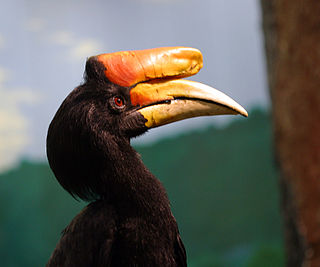
Buceros is a genus of large Asian hornbills.

The southern ground hornbill is one of two species of ground hornbill, both of which are found solely within Africa, and is the largest species in the hornbill order worldwide. It can be found in the southern regions of Africa, ranging from Kenya to South Africa. Within these regions, they inhabit both woodlands and savannas. The other species of the genus Bucorvus is the Abyssinian ground hornbill, B. abyssinicus.

Ocyceros is a genus of birds in the family Bucerotidae. Established by Allan Octavian Hume in 1873, it contains several species that are limited to the Indian subcontinent.

Penelopides is the genus of relatively small, primarily frugivorous hornbills restricted to forested areas of the Philippines. Their common name, tarictic hornbills, is an onomatopoetic reference to the main call of several of them. They have a ridged plate-like structure on the base of their mandible. All are sexually dimorphic: males of all species are whitish-buff and black, while females of all except the Mindoro hornbill are primarily black.

Bycanistes is a genus of medium to large, primarily frugivorous hornbills found in the forests and woodlands of Sub-Saharan Africa. They have often been included in the genus Ceratogymna, but today most authorities consider them separate. All species in this genus have black and white plumage. The plumage of the sexes is similar, but the casque of the male is larger than that of the female.

The African grey hornbill is a member of the hornbill family of mainly tropical near-passerine birds found in the Old World. It is a widespread resident breeder in much of sub-Saharan Africa and the southwest of the Arabian Peninsula. The African grey hornbill has escaped or been deliberately released into Florida, USA, but there is no evidence that the population is breeding and may only persist due to continuing releases or escapes.
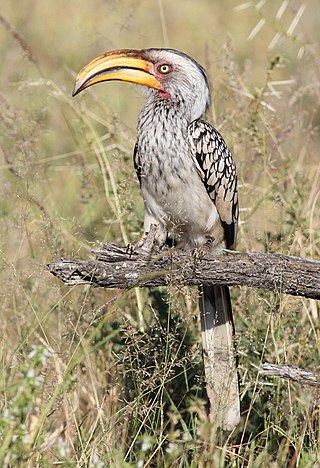
The southern yellow-billed hornbill is a hornbill found in southern Africa. Yellow-billed hornbills feed mainly on the ground, where they forage for seeds, small insects, spiders and scorpions. This hornbill species is a common and widespread resident of dry thornveldt and broad-leafed woodlands. They can often be seen along roads and water courses.
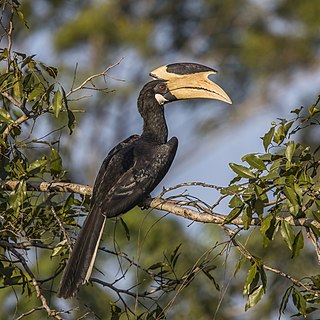
The Malabar pied hornbill, also known as the lesser pied hornbill, is a bird in the hornbill family, a family of tropical near-passerine birds found in the Old World.
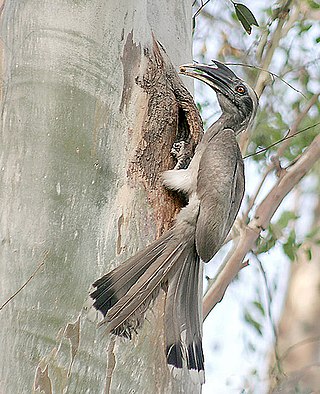
The Indian gray hornbill is a common hornbill found on the Indian subcontinent. It is mostly arboreal and is commonly sighted in pairs. It has grey feathers all over the body with a light grey or dull white belly. The horn is black or dark grey with a casque extending to the point of curvature of the horn. It is one of the few hornbill species found in urban areas in many cities where they are able to make use of large trees in avenues.
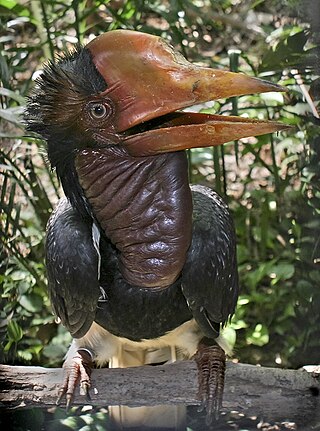
The helmeted hornbill is a very large bird in the hornbill family. It is found on the Malay Peninsula, Sumatra, Borneo, Thailand and Myanmar. The casque accounts for some 11% of its 3 kg weight. Unlike any other hornbill, the casque is almost solid, and is used in head-to-head combat among males. It is a belief among the Punan Bah that a large helmeted hornbill guards the river between life and death.
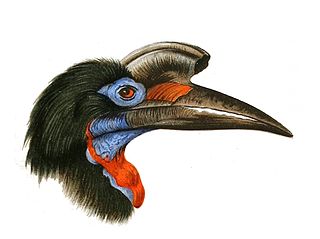
The ground hornbills (Bucorvidae) are a family of the order Bucerotiformes, with a single genus Bucorvus and two extant species. The family is endemic to sub-Saharan Africa: the Abyssinian ground hornbill occurs in a belt from Senegal east to Ethiopia, and the southern ground hornbill occurs in southern and East Africa.
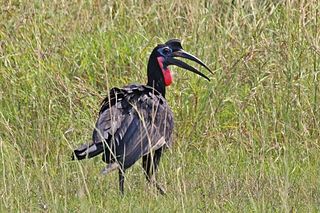
The Abyssinian ground hornbill or northern ground hornbill is an African bird, found north of the equator, and is one of two species of ground hornbill. It is the second largest species of African hornbill, only surpassed by the slightly larger southern ground hornbill.

The great hornbill, also known as the concave-casqued hornbill, great Indian hornbill or great pied hornbill, is one of the larger members of the hornbill family. It occurs in the Indian subcontinent and Southeast Asia. It is predominantly frugivorous, but also preys on small mammals, reptiles and birds. It has been listed as Vulnerable on the IUCN Red List since 2018. It is known to have lived for nearly 50 years in captivity. Due to its large size and colour, and importance in many tribal cultures and rituals, the Government of Kerala declared it as the official Kerala state bird. It is also the state bird of Arunachal Pradesh.
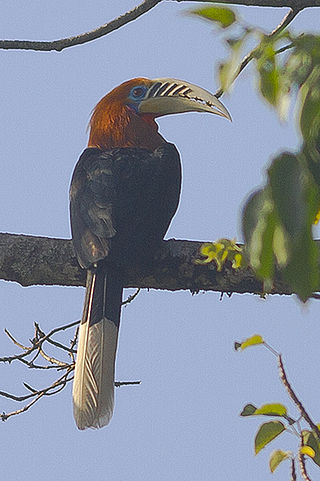
The rufous-necked hornbill is a species of hornbill in Bhutan, northeastern India, especially in Arunachal Pradesh, Indian Subcontinent and Southeast Asia. It is locally extinct in Nepal due to hunting and significant loss of habitat. There are less than 10,000 adults left in the wild. With a length of about 117 cm (46 in), it is among the largest Bucerotine hornbills. The underparts, neck and head are pigmented as a rich rufous in the male, but black in the female.

The common dwarf mongoose is a mongoose species native to Angola, northern Namibia, KwaZulu-Natal in South Africa, Zambia and East Africa. It is part of the genus Helogale, along with the Ethiopian dwarf mongoose.

Blyth's hornbill, also known as the Papuan hornbill, is a large hornbill inhabiting the forest canopy in Wallacea and Melanesia. Its local name in Tok Pisin is kokomo.

Bucerotiformes is an order of birds that contains the hornbills, ground hornbills, hoopoes and wood hoopoes. These birds were previously classified as members of Coraciiformes. The clade is distributed in Africa, Asia, Europe and Melanesia.

The western long-tailed hornbill is a species of hornbill found in humid forests of West Africa. It was formerly considered to be conspecific with the eastern long-tailed hornbill with the English name "white-crested hornbill".


















